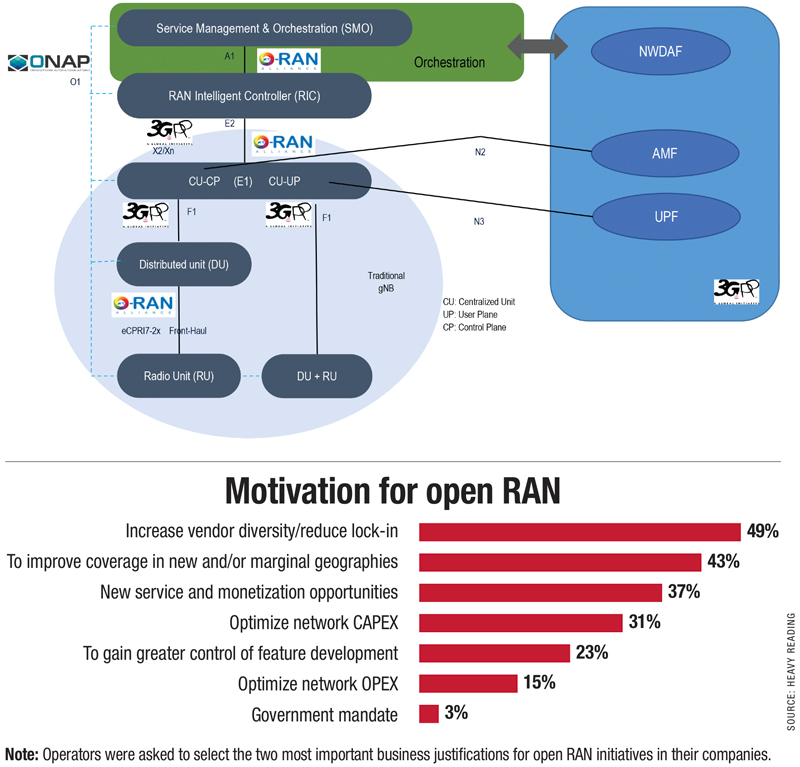Is Open RAN Ready?
By David Debrecht
The origins of Open RAN and the O-RAN Alliance go back to the merger of the xRAN Forum and C-RAN Alliance in 2018. The xRAN Forum was founded in 2016 by multiple mobile network operators and Stanford University to promote a software based, extensible radio access network (RAN) based on standardized architectures. The concept of a centralized (or cloud) RAN has been introduced by multiple operators, vendors, and universities as far back as 2010. The first C-RAN international workshop was held in China in 2010. Since the creation of the O-RAN Alliance in 2018, a tremendous amount of progress has been made in the advancement of standards and specifications toward development and deployment of Open RAN solutions.
Open RAN is essentially an ongoing shift in mobile network architectures that enables service providers the use of subcomponents from a variety of vendors. This is important because it enables optionality in creating solutions for open, multi-vendor networks with enhanced control and flexibility. There are three main components of Open RAN: centralization/cloudification, virtualization, and disaggregation. The O-RAN Alliance has developed an architecture to allow operators to flexibly deploy Open RAN, based on these components and added other functions for real time and near-real time control and application deployment as well as a multi-vendor service management and orchestration framework for the architecture. The figure below shows the O-RAN Alliance architecture and interfaces, including where each interface is specified.
Motivation for Open RAN
Open RAN, based on O-RAN Alliance specifications, has the potential of being more cost effective and more flexible compared to traditional RAN deployments. The specifics around cost savings have been a matter of significant debate for a few years. A simple Internet search will return studies that show Open RAN total cost of ownership (TCO) savings ranging from anywhere between 10% and 50%, with a few suggesting that it will actually cost more than traditional deployments. Deployment scenarios are a large factor in this variation – deployment location, greenfield, brownfield, distributed, centralized, virtualized, and cloud deployments being just some of the variations. Operators who have adopted and deployed Open RAN generally agree that there are cost savings associated with Open RAN, however there are other reasons for adopting Open RAN in networks. The second accompanying figure shows a recent Heavy Reading study on motivations for Open RAN.

The Pace of Operator Adoption
Regardless of the level of TCO savings, operators are making plans to adopt the concepts and architectures being developed by the O-RAN Alliance. Early adopter operators have already deployed their networks based on Open RAN and many of the major global mobile network operators have made commitments, are making plans, are trialing, or are studying these concepts for future deployment. The question isn’t IF aspects of Open RAN will be deployed, the questions are when and how much. Open RAN is the fastest growing RAN segment even if also the smallest. There are some barriers to adoption that must be addressed which include feature parity and performance of Open RAN equipment and system integration efforts required in an Open RAN multi-vendor environment.
Incumbent RAN vendors have been developing their 3GPP based solutions for well over 35 years. Today’s 5G technology and performance are built on original specifications for GSM 2G networks which were first deployed in the early 1990s. Given that the O-RAN Alliance has only been around for about five years and key interface specifications have only been complete for a few years, it is not surprising that new vendors developing Open RAN equipment have not caught up in terms of features and performance. New vendors in the Open RAN ecosystem have made incredible progress in their solutions and are expected to be on par with traditional vendors soon.
One of the key drivers for potential cost savings with Open RAN is the level of interoperability and “plug-and-play” capabilities of the ecosystem. However, Open RAN components from different vendors are not “plug-and-play” yet and require a fair amount of complex systems integration. The RAN intelligent controller (RIC) and service management and orchestration (SMO) modules, crucial for automated management and optimization, are still underdeveloped, making multi-vendor Open RAN difficult to deploy and operate at scale. Therefore, Open RAN falls behind incumbents’ integrated RAN gear in scalability, coverage, capacity, and reliability; closing this gap is a primary target of Open RAN vendors.
CableLabs leadership as key industry enabler and neutral host integrator
For more than two years, CableLabs has been at the forefront of the effort to understand Open RAN maturity, level of interoperability among vendors and driving a true “plug-and-play” ecosystem. With its partners and vendors, CableLabs developed and deployed a fully virtualized network environment to host both cable and mobile network functions. Within the same Kubernetes based HW clusters, the organization has successfully integrated multiple 5G core networks and multiple vendors’ Open RAN solutions. CableLabs was chosen as the host lab for NTIA’s 5G Challenge in both 2022 and 2023, and approved as the first Open Test and Integration Center in North America by the O-RAN Alliance.
With CableLabs’ efforts in addition to the 5G Challenge, it has worked with more than 15 different vendors’ Open RAN solutions and developed methods for testing and evaluating compliance prior to connecting systems together and attempting multi-vendor systems integration. During the 2022 Challenge, CableLabs showed that it was possible to bring three different vendors together (one each CU, DU, RU) who have not performed any previous systems integration and get the e2e solution up and running in just five weeks. This does not mean multi-vendor system integration is easy or ready for widescale multi-vendor commercial deployments, but it does show it is possible to shrink the current SI timelines with the right approach. Basically, achieving interoperability based on compliance, not integration.
Path to an abundant and thriving Open RAN ecosystem is within reach
The key to driving down multi-vendor Open RAN SI costs and timelines is agreement and adoption of clear and specific profiles for the 3GPP and O-RAN Alliance interfaces. In both 3GPP and O-RAN Alliance interface specifications there are multiple options, configurations and assumptions made by the different vendors for their side of the various interfaces. Unless these are very well aligned, the effort to integrate the different vendor solutions will remain high and costly. Agreeing to and adopting specific profiles and then testing and certifying compliance to these profiles will drive down both cost and time required to bring vendors’ solutions together successfully. Basically, getting to “plug-and-play” through adoption and conformance of interface profiles.
During MWC 2023, one big question that was asked, discussed, and debated was, ‘is Open RAN based on O-RAN Alliance specifications ready for commercial deployments?’ This is not an easy question to answer. Given that multiple operators have deployed Open RAN in commercial networks, you can conclude the answer is yes. However, Open RAN deployments remain small, and the effort required to bring multiple vendors into a single network is still quite high. There is more work to be done, but it is possible. The O-RAN Alliance needs to complete the work for the RIC and SMO specifications. The industry needs to figure out how to drive down the cost and time required for system integration. Open RAN vendors need more time and investment to develop their solutions to meet the current state of operators’ networks. The ecosystem will get there, but the work must be done now to realize the benefits that Open RAN promises in the future.
 David Debrecht,
David Debrecht,
Vice President of Wireless Technologies,
CableLabs
David Debrecht is vice president of Wireless Technologies at CableLabs. In this role, he directs the execution and adoption of new wireless technologies and specifications for the secure delivery of high-speed data, video, voice and next generation services for CableLabs members and the industry. With over 30 years of experience with wireless technology solutions in both government and commercial applications, he has served in a broad range of technology and product development roles, including various positions in R&D, product management, and technology development. David started his career at General Dynamics developing radar, radar warning, and electronic countermeasures platforms on the F-16 fighter aircraft. He moved to telecommunications in the mid-’90s and started the commercial side of his career with Nokia on radio base station R&D. He successfully filled many different roles within Nokia for 25 years, the latest of which, before moving to CableLabs, was CTO for the U.S. and Federal business in the customer operations organization.
Source: Heavy Reading, diagram provided by author


